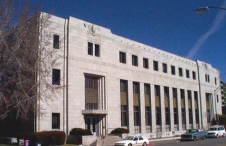Vernacular Architecture in Nevada
Vernacular architecture is a term encompassing a range of building forms, types, and styles. In the past, the term referred to folk or traditional building by people with no formal architectural training. Today, scholars define the term more broadly to include the architecture of specific regions or popular, ordinary buildings, such as shopping malls, even if designed by trained architects. Vernacular architecture can also refer to an approach to architectural studies that examines the relationships between everyday life and people. This broader definition recognizes the diversity of vernacular architecture and includes twentieth and twenty-first-century examples.
As a place with a long history of human habitation, Nevada has a variety of vernacular architecture. In addition, the arid environment of the Great Basin and the state's boom-and-bust economy have shaped building design in Nevada. For example, wood, a widely available and used material in the eastern part of the United States, is scarce in much of the state and has to be shipped in from other places. Nevada's economy, dominated in the nineteenth century by mining, railroads, and ranching, and in the twentieth and twenty-first centuries by tourism, has also influenced building construction.
Some of the earliest examples of vernacular architecture include the archaeological remains of prehistoric Native American sites. Examples are the circular, subterranean pit houses built by the Basketmaker culture around 300 BCE and later by the Anasazi circa 500–700 near present-day Overton. Pit houses had mud walls that supported wooden roofs covered with adobe mud.
Nineteenth-century and early twentieth-century Euro-American settlers also constructed adobe buildings, particularly in the southern part of Nevada, because of the scarcity of large trees for wood-frame construction. The Las Vegas Mormon Fort (1855) survives as an early example.
Gold and silver mining booms beginning in the late 1850s brought transplants from other parts of the United States, Europe, and China. These new arrivals tended to erect structures that resembled what they were familiar with back home, but that were adapted to the conditions of their new towns. Some builders made use of unusual, but abundant, materials found in mining towns. Tom Kelly erected his Rhyolite house in 1906 with 20,000 beer bottles held together by adobe mortar. Though most of Rhyolite's buildings are gone, the bottle house remains as a testament to the ingenuity of Nevada's vernacular builders. Other builders used corrugated metal to clad the roofs and walls of mining buildings, such as the Donovan Mill Complex (1890) in Silver City.
Ranching attracted Basques, many of whom worked as sheepherders. Basque-American communities grew up around hotels located in towns such as Winnemucca and Elko. These buildings exhibited no specific style or form, but became a distinct building type in Northern Nevada. Today few of these buildings function as hotels, but they continue to house popular Basque restaurants.
No overview of vernacular architecture in Nevada would be complete without discussing the architecture of gaming and tourism. Casinos fit into a broader definition of vernacular architecture, which includes buildings designed by trained architects but for popular appeal. Architects based in Los Angeles and known for their creations of roadside architecture, such as coffee shops and motels, designed many mid-twentieth century casinos. Post–World War II casinos, such as the Flamingo Hotel (1946; demolished), reflected the low-slung, angular appearance of modern architecture with a hint of the exotic, seen in the lush plantings surrounding them. Even the megaresorts erected today tap into tourists' desires for fantasy, whether they reflect another place and time, such as Luxor (1993 and ongoing), or sheer opulence, as in Wynn Las Vegas (2005).
Vernacular architecture continues to evolve in Nevada. Whether it embodies the traditions of ethnic groups in small, rural towns or twenty-first-century suburban sprawl in Las Vegas, the study of everyday buildings adds to our understanding of the state.
Article Locations
Related Articles
Further Reading
None at this time.





